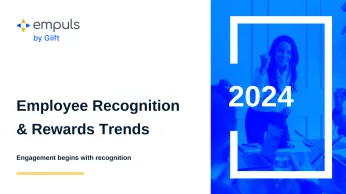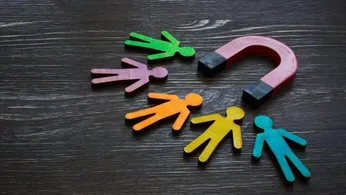Pada halaman ini
‘Whatever’ was polled as the most annoying word by 34% of Americans in 2019. And the chances that you have said or maybe heard a similar annoying word in your workplace, too.
Sekiranya benar, maka anda perlu mengelakkan penyebaran budaya ini atau bersedia menghadapi kesulitan pada masa akan datang. Jalan ke kepuasan pekerja bermula di mana rasa hormat di tempat kerja terletak.
Penghormatan tidak dihargai kerana ia diambil mudah di tempat kerja dan sering disalahpahami dalam konteks yang berbeza. Oleh itu, mari kita fahami maksud hormat terlebih dahulu.
Makna penghormatan di tempat kerja
Ia mempunyai beberapa makna tetapi tidak mempunyai definisi yang tepat.
Richard Branson berkata; "Hormat adalah bagaimana memperlakukan sesiapa sahaja, bukan hanya orang yang anda mahu menarik perhatian."
Employee respect in the workplace must be independent of discrimination, i.e., regardless of age, designation, gender, color, location, etc. Whether the company's CEO or janitor works there, both deserve to be respected.
However, co-workers must not take it for granted. The leaders/workers need to be professional, polite, and respectful to be treated equally.
Tetapi adakah ia benar-benar penting, anda mungkin bertanya?
We have drawn a few important points below to illustrate how far a respected workplace can take you and your company.
Kepentingan menghormati di tempat kerja
Kami tidak perasan rasa hormat sehingga tidak hadir. Jadi, apa yang berlaku apabila ia tidak hadir? Para pekerja mungkin merasa tidak selesa pada mulanya, tetapi jika ia diteruskan, mereka akan merasa tertekan atau mungkin meninggalkan syarikat.
Ia tidak berakhir di sini. Penyelidikan yang luas terhadap 20,000 pekerja di seluruh dunia (yang dijalankan oleh Christine Porath dan Tony Schwartz, dan HBR) membuktikan bahawa semakin tinggi penghormatan yang diberikan majikan, semakin banyak penglibatan pekerja.
Ia di sini.
Dan mengapa anda perlu peduli? Kerana pekerja yang terlepas menelan belanja syarikat AS sehingga $ 550 bilion setahun, kata Forbes. Dan inilah cara persekitaran yang menghormati dapat membantu.
1. Meningkatkan kepuasan kerja
A healthy work environment, where employees’ efforts are addressed, fuels the motivation to perform best. In a survey conducted by the Society for Human Resource Management (SHRM), 72% of employees rated 'respectful treatment' as a top-rated behavior for job satisfaction.
2. Mengurangkan tekanan kerja dan meningkatkan tenaga kerja
Satu kajian, Tekanan Tempat Kerja: Kesan dan Hasil, oleh Chestnut Global Partners dan SHRM, menunjukkan bahawa rasa tidak hormat adalah punca utama tekanan di kalangan pekerja.
Salah satu sebab utama di sebalik kejayaan syarikat (terutamanya dikendalikan oleh banduan wanita, 425 daripada 650) dan Jim Hooker (CEO) adalah; Dia menghargai wanita yang dipenjarakan (biasanya dianggap sebagai menurunkan nilai kepada masyarakat) dengan memberi mereka identiti Televerdians.
3. Leads to a knowledgeable environment and company’s growth
Steve Jobs’ success, one of the inspirations to many CEOs, is often credited to his bad behavior with others. However, there’s so much behind the curtains. Edwin Catmull (Pixar’s co-founder), who worked with Steve Jobs for 26 years, says that Jobs’ greatest success came only after he changed from insensitive and impolite to empathetic.
Oleh itu, tingkah laku pemimpin memutuskan kesihatan tempat kerja dan pertumbuhan syarikat.
Contoh menunjukkan rasa hormat di tempat kerja
Orang mempunyai perspektif yang berbeza, dan hasutan kepada seseorang mungkin biasa kepada yang lain. Oleh itu, rasa hormat di tempat kerja menjadi sukar bagi majikan / penyelia dan juga rakan sekerja.
Rasa tidak hormat yang tidak disengajakan menjadi kebiasaan jika tidak ditangani.
Berikut ialah contoh penghormatan di tempat kerja:
- Melayan pekerja dengan hormat tanpa mengira agama, warna kulit, bangsa, jantina, lokasi, kecacatan fizikal / lisan / mental, umur, atau apa sahaja yang membezakannya.
- Mendengar dan mempertimbangkan cadangan orang lain secara aktif jika berguna.
- Perselisihan sopan tanpa merendahkan logik orang lain dalam mesyuarat atau perbincangan peribadi.
- Kritikan dan penghargaan yang membina terhadap kemahiran dan dedikasi orang lain.
- Penerimaan kelemahan orang lain dan tidak merendahkan mereka atas dasarnya.
- Mengendalikan pertikaian dengan sihat.
- Tingkah laku yang tidak berat sebelah di tempat kerja ketika datang ke promosi.
- Menggalakkan penyertaan aktif ahli pasukan dalam mesyuarat/perbincangan.
- Larangan tindakan toksik seperti taun, gangguan, buli, menggigit, memanggil nama, memonopoli, dan memperkecilkan orang lain di tempat kerja.
- Penggunaan ucapan rasmi dan kata-kata sopan seperti terima kasih dan sila dalam ucapan.
Kegigihan dan punca tidak menghormati
Eksekutif itu mengaku bahawa dia menjadi kuat dan marah dengan rakan sekerjanya untuk menyelesaikan sesuatu, kerana itulah yang dilihatnya di kalangan seniornya. Oleh itu, menyelesaikan punca rasa tidak hormat adalah lebih penting daripada hanya mengamalkan tingkah laku hormat.
Berikut adalah sebab-sebab biasa tidak menghormati di tempat kerja:
- Fungsi mesin atau kegagalan sistem yang tidak betul boleh menyebabkan tingkah laku merengsa yang menjadi punca kekecewaan di kalangan rakan sekerja dan tidak menghormati di tempat kerja.
- Sebab peribadi seperti kebimbangan, kemurungan, rasa tidak selamat, agresif, dan lain-lain, juga boleh mencetuskan kemarahan.
- Kecacatan mental, penyalahgunaan bahan, atau gangguan personaliti boleh menjadi sebab dalam beberapa kes tidak menghormati di tempat kerja.
- Perbezaan budaya atau generasi juga merupakan salah satu sebab di sebalik tingkah laku yang tidak sopan.
- Salah komunikasi antara penyelia dan pekerja juga boleh menyebabkan rasa tidak hormat.
Walau bagaimanapun, tingkah laku itu berterusan kerana sebab-sebab berikut:
- Tingkah laku yang tidak sopan dan persekitaran kerja yang tidak menguntungkan adalah seperti ayam dan telur. Dan satu membawa kepada kebangkitan yang lain. Tinjauan ISMP 2013 menyimpulkan bahawa hanya satu perempat syarikat menangani tingkah laku yang tidak sopan.
- Managers are likely to shield workers' toxic behavior if they are high-revenue producers. Such incidents lead to the persistence of disrespect in the workplace.
- Juga, dalam beberapa kes, ketoksikan berterusan kerana pengurus tidak mampu mengendalikan keadaan.
Bagaimana untuk mengamalkan rasa hormat di tempat kerja?
Mengamalkan rasa hormat di tempat kerja berpunca daripada dua langkah utama; pencegahan dan penerimaan. Mari kita pelajari setiap daripada mereka secara terperinci.
1. Prevention of disrespectful behavior
Berikut adalah beberapa cara untuk mencegah ketoksikan di tempat kerja.
-> Shut the disrespectful behavior quickly
Seperti yang kita bincangkan sebelum ini, rasa tidak hormat menular. Ia merebak dari orang ke orang. Oleh itu, menangani tingkah laku menjadi keperluan segera. Kejahilan hanya akan berkembang tidak menghormati dan mewujudkan persekitaran kerja toksik.
Lebih-lebih lagi, tindakan untuk membuat tingkah laku sedemikian tidak dapat diterima menunjukkan kepentingan pekerja di tempat kerja.
Facebook benar-benar komited dalam pencegahan tingkah laku yang tidak sopan. Heidi Swartz, ketua undang-undang pekerjaan global syarikat, menyatakan bahawa kami melatih pekerja bahawa jika rakan sekerja mengatakan "tidak" untuk pergi pada tarikh dengan anda, anda tidak bertanya kepadanya lagi. Walau bagaimanapun, "Saya sibuk" atau "Saya tidak boleh malam itu" juga dianggap jelas "tidak."
-> Are you the problem?
Tingkah laku anda, sebagai penyelia / ketua pasukan atau CEO syarikat, menetapkan contoh kepada pasukan dan seluruh tempat kerja. Oleh kerana otak manusia berwayar, sukar untuk melihat diri kita melakukan kesilapan yang kita dapati tidak sesuai pada orang lain.
Profesor Universiti Stanford Bob Sutton berkongsi kisah seorang CEO Silicon Valley dan bagaimana pasukannya membuatnya menyedari tingkah lakunya yang buruk. Ketua Pegawai Eksekutif pernah menghina penyelia dalam mesyuarat dengan membandingkannya dengan sayur-sayuran seperti anda lebih bodoh daripada kepala salad.
Pasukan itu membayarnya kembali dengan bijak. Suatu hari CEO datang ke mesyuarat, dan dia mendapati ketua-ketua yang kecewa dan bukannya ahli pasukannya di tempat mereka. Beberapa kepala mempunyai mata, ada yang tersenyum, dan ada yang mempunyai cermin mata hitam.
Malah CEO menemui kepala salad di tempatnya. Kemudian, CEO menerima bahawa dia telah menjadi sukar dalam pasukannya ketika datang ke pertumbuhan dan pendapatan syarikat. Juga, dia menyedari kata-katanya.
-> Conduct surveys & feedback
Menjalankan tinjauan dan maklum balas untuk mengetahui sama ada tingkah laku tidak sopan bernafas di tempat kerja anda. Pada tahun 2019, satu kajian oleh NCBI mendapati bahawa pekerja kulit hitam menghadapi 60% lebih banyak diskriminasi daripada orang kulit putih di tempat kerja. Kejadian sedemikian membawa kepada tekanan dan ketidakpuasan kerja. Maklum balas yang kerap menghalang tingkah laku yang tidak sopan dan memastikan tempat kerja sihat dan terkawal.
2. Adoption of respectful behavior
Berikut ialah cara anda boleh mengalu-alukan tingkah laku hormat di tempat kerja anda.
-> Frame a respectful workplace policy
Dasar tempat kerja yang menghormati membantu pekerja mengetahui had toleransi di tempat kerja. Juga, merangka dasar tempat kerja akan memberi mereka rasa kerja semula pada diri mereka sendiri.
Lukiskan senarai tingkah laku yang tidak boleh diterima dan garis panduan (untuk mengelakkan tingkah laku) dalam dasar untuk menguatkuasakan saling menghormati di tempat kerja. Anda juga boleh menggariskan penalti yang mengundang jika salah laku berterusan.
Assemble the supervisors in discussion to craft the policy. You can even consider employees’ (former or current) feedback and weave them into the company’s processes to improvise. Heather Huhman (founder and president of Come Recommended) says that employee intervention is a sign of a respected workplace policy.
She suggests that an HR policy must be fluid, and the supervisor must revisit the rules to see if they still make sense.Huhman also says that "if everyone wants to have a specific rule (for example, no dating in the workplace), it must be implemented".
-> Appreciate the respectful employees
Penghargaan memberi kesan yang mendalam, bukan sahaja kepada individu yang mendapat penghargaan tetapi juga kepada orang-orang di sekelilingnya.
Rakan sekerja, yang menyaksikan orang lain mendapat penghargaan, berusaha untuk menjadi seperti orang lain atau lebih baik lagi. Itulah cara yang besar untuk menggalakkan tingkah laku hormat di tempat kerja kerana ia juga tidak termasuk idea untuk menghormati diberikan.
Create a respectful culture with Empuls
Respect is foundational to creating a healthy company culture and productivity, retention, and long-term success.
To connect this with Empuls, here's how the platform directly supports fostering a culture of respect and recognition in the workplace:
1. Detect & prevent disrespect with surveys
Empuls empowers HR and leaders to listen continuously through:
- eNPS and pulse surveys to detect disengagement early.
- Lifecycle surveys (from onboarding to exit) that reveal friction points and areas lacking respect or inclusion.
- 360° feedback and anonymous surveys to identify disrespectful behaviors—especially those that go unreported.
These insights drive targeted, respectful culture initiatives.
2. Promote respect with recognition
Empuls helps build a culture of appreciation through:
- Peer-to-peer recognition for everyday contributions.
- Core values-based awards to reinforce respectful behaviors.
- Smart nudges from Em (AI assistant) that prompt timely appreciation, closing the “recognition gap.”
Automated service awards and milestone celebrations to show long-term respect and gratitude.
Recognition isn’t occasional—it’s continuous and inclusive with Empuls.
3. Facilitate respectful communication
Empuls’ Social Intranet boosts respectful, transparent dialogue via:
- Townhalls with interactive posts, polls, and AMAs.
- Wishboards for birthdays, life events, and service anniversaries.
- Community groups that create psychological safety and foster inclusivity.
With features like emojis, likes, GIFs, and moderation controls, conversations stay fun, kind, and positive.
4. Reinforce positive behavior with rewards
Empuls encourages respectful engagement by:
- Rewarding collaborative behavior, wellness, learning, and team efforts.
- Offering non-monetary and monetary incentives via a rich global catalog: gift cards, experiences, wellness, donations, and more.
Employees who live the values are appreciated publicly and rewarded meaningfully.
5. Manager & HR enablement
Empuls provides:
- AI-powered manager insights to ensure no team member is left unrecognized.
- Automation tools for consistent reward cycles and milestone celebrations.
- Privacy and branding controls to maintain a safe, professional digital workspace.
Let’s outline a Respectful Workplace Policy leveraging Empuls features. This policy will serve two purposes:
-> Set clear expectations for respectful behavior.
-> Use Empuls to reinforce, recognize, and reward that behavior.
Respectful workplace policy (Empuls-enabled)
Following is how you set a respectful culture with Empuls:
1. Tujuan
To foster a workplace where every employee feels valued, heard, and safe through respectful, inclusive, and professional behavior. This policy supports our DEI and engagement goals and is operationalized through Empuls.
2. Scope
Applies to all employees, contractors, and interns, across physical and digital workspaces—including Empuls' social feed, community groups, and recognition features
3. Core principles
Treat everyone with dignity—regardless of title, background, or beliefs.
- Communicate openly but with empathy
- Embrace diversity of thought and background.
- Offer feedback constructively and accept it graciously.
- Celebrate each other's wins, milestones, and contributions.
- Use digital platforms (like Empuls) responsibly and respectfully.
4. Behaviors that reflect respect
To be recognized and encouraged via Empuls Rewards & Recognition:
- Active listening and inclusive collaboration
- Timely appreciation of peers (using peer-to-peer recognition)
- Polite disagreement during team discussions
- Inclusion of all voices in meetings (especially underrepresented ones)
- Sharing thoughtful feedback in surveys or community discussions
Reward these behaviors with values-based or spot awards on Empuls.
5. Unacceptable behaviors
To be flagged via surveys, feedback, or community moderation:
- Bullying, taunting, or belittling others
- Discrimination (age, gender, race, etc.)
- Interrupting or ignoring others’ contributions
- Toxic gossip, passive aggression, or sarcasm
- Abusive or unprofessional language in Empuls posts/comments
HR or designated moderators will review flagged content or survey trends.
6. Feedback & enforcement
Use eNPS, pulse, and 360° surveys in Empuls to gather feedback regularly:
- Employees can report disrespect confidentially.
- Empuls admins and HR will take action based on trends and direct feedback.
- Repeat violations will lead to progressive disciplinary action.
7. Recognition & celebration
Promote respect by celebrating:
- Core value champion
- Milestone service anniversaries
- Respectful team players nominated monthly
- Use AI-powered nudges from Em to remind managers to recognize deserving employees.
Display recognitions on Empuls’ Wall of Fame or digital displays across the office.
8. Communications & awareness
Post this policy on the Empuls Social Intranet:
- Use interactive content like polls or quizzes to raise awareness.
- Reinforce during townhalls and community groups.
Schedule a call with Empuls to understand the tailored specifics that you will avail to create a culture of respect.
Kesimpulan
Memang benar bahawa apabila rasa hormat hadir di tempat kerja, sangat sedikit orang yang mengaguminya, dan sangat sedikit syarikat. Tetapi ketiadaannya boleh menghasilkan akibat sedemikian yang boleh membawa kepada penurunan pertumbuhan syarikat, bakat cemerlang, kadar pengekalan pekerja, dan banyak lagi.
Ringkasnya, syarikat itu mula tenggelam. Oleh itu, pastikan mata terbuka untuk mengenal pasti sama ada rasa hormat berada di tempat kerja dan mengambil langkah-langkah yang perlu untuk mengekalkannya.
Artikel Trending
150 Contoh Semakan Prestasi
Mesej Tahun Baru Korporat Motivasi
Soalan Ulasan Rakan Sebaya untuk Penilaian Berkesan
Contoh Matlamat Prestasi Pekerja
Strategi untuk Mengurangkan Ketidakhadiran Pekerja
Tingkah Laku Pekerja untuk Mengenali dan Memberi Ganjaran
Memotivasikan Mesej Penghargaan Pasukan













